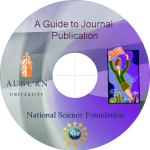

Finding, Tracking and Analyzing Citations
A citation is a reference to a source that appears in another source. For journal papers, a citation is a reference appearing in a published journal paper which references another published journal paper. For practical purposes, since citations are identified and summed using online databases, such as ISI Web of Science, only abstracted sources are counted (this includes some conference proceedings along with journals). A citation can be from your own work (a "self citation") but most citations are from third party authors.
Citations are becoming more important as indicators and metrics for assessing publication performance of academics. Some institutions, especially those in Europe, have even adopted a formula which includes the papers published weighted by journal impact factor and melds in citations to those papers. Given the proliferation of online data bases and the improved sophistication of search engines, there is little doubt that this metric based approach will become more pervasive in the future. Some U.S. institutions are now subscribing to online services which can pull up their institution's citations in a certain technical area for a specified time period, and compares the number to other institutions' numbers. For tenure and promotion cases, considering citations is becoming a routine part of the assessment and deliberation. It is not enough to publish - you must consider the value imparted by your papers - and this is currently measured most often by citations.
For an article of your's to be cited, it must appear in print, be read, contribute in some way to new research, and then be cited in a paper that is written, accepted and printed that describes that new research. You can see it is a long line of steps from a published paper of your's to a published citation. Some papers will never be cited while others will snowball in citations.
The videos in this CD showing usage of ISI Web of Science include the exact methods to pull citations and the information you can gain concerning your or other's citations. You can also put a citation tracking mechanism on your published articles through ISI Web of Science so that you receive a detailed email notification whenever your papers are cited by articles abstracted in ISI Web of Science.
Click below to watch the videos on using ISI Web of Science for citations:
- Create a Citation Alert
- Individual Citations
- Citation Report
- Sort by Number of Citations
- Citation Report Final Look

Being cited is not an absolute measure of quality or importance, but it is easily counted and does measure impact to the body of knowledge. It is your advantage to understand how citations come to be, how you can access this information and how institutions and academic decision makers are obtaining and using that information.
Articles on Citations:
Adam, D., "Citation analysis: The counting house," Nature, 2002, 415: 726 - 729
Garfield, E., "Validation of Citation Analysis," Journal of the American Society for Information Science, 1997, 48(10): 962
Hakanson, M., "The impact of Gender on Citations: An Analysis of College and Research Libraries," Journal of Academic Librarianship and Library Quarterly, July 2005, 312-322
MacRoberts, M. H. and MacRoberts, B. R., "Problems of citation analysis: A critical review," Journal of the American Society for Information Science, 1988, 40(5): 342-9
MacRoberts, M. H. and MacRoberts, B. R., "Brief communication. Citation content analysis of a botany journal," Journal of the American Society for Information Science, 1997, 48(3): 274-275
Reed, K. L., "Citation analysis of faculty publication: beyond Science citation index and Social science citation index," Bulletin of the Medical Library Association, October 1995, Vol. 83, 503-8
Trifunac, M. D., "A note on publication and citation rates of female academics in earthquake engineering," Soil Dynamics and Earthquake Engineering, November 2006, Volume 26, Issue 11, 1063-1075
Trifunac, M. D., Lee, V. W., "A study on the relative ranking of twelve faculty of the USC civil engineering department: experiments with the science citation index expanded," Department of Civil Engineering, Report No. CE 04-01, University of Southern California, 2004
- Click here to see the part of this study on how to analyze and interpret citations.
- Click here to see Appendix A - Impact Factors
- Click here to see Appendix B - Journal Ranking and Average Impact Factors of Basic and Allied Sciences created by Acad. Prof. Dr. Ioan-Iovitz Popescu on July 2000
- Click here to see Appendix C - Mean Publication Trends Among University Professors between 1960 and 2000.
- Click here to see Appendix D - A Note on the Ranking of Female Academics in Civil Engineering Departments Specializing in Mechanics and Earthquake Engineering.
